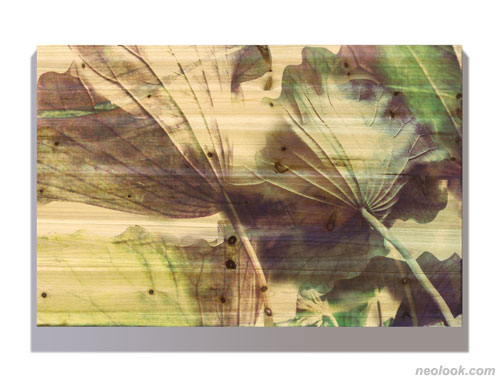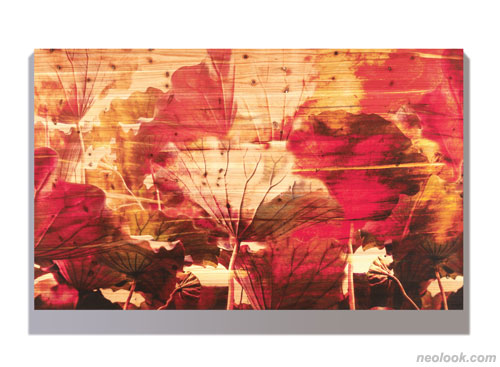- ● homepage
- ● archives
- ● restoration
- ● books
- ● big banners
- ● post board
- ■ neo's search
- ■ about us
- ■ 게재방법 안내
- 개인정보처리방침

- [email protected]
- Tel. 02_335_7922
- Fax. 02_335_7929
- 10:00am~04:30pm
- 월요일~금요일
- 3/3(월) 대체공휴일

Sky Lotus
송은주展 / SONGEUNJOO / 宋銀珠 / mixed media 2018_1121 ▶ 2018_1130
● 위 이미지를 클릭하면 네오룩 아카이브 Vol.20140929i | 송은주展으로 갑니다.
오프닝 콘서트 / 2018_1121_수요일_06:00pm
관람시간 / 11:00am~06:00pm
갤러리 FM Gallery FM 서울 종로구 율곡로 57 우리은행 재동지점 2층
삼나무 회화로 해석한 하늘 미학 ● 현대인은 테크놀로지의 발달로 다양한 정보의 혜택과 물리적 공간을 뛰어 넘는 삶을 누리고 있다. 그 결과 각자의 위치에서 각자의 역할 범위가 더 넓어졌으며 삶은 더욱 분주해졌다. 현대인의 분주한 삶이 한계점에 도달하게 되면, 휴식과 함께 자연을 바라보게 되고, 자기 자신에 대한 사유를 시도하게 된다. 나는 누구이며, 나는 무엇을 해야 하는지, 내가 통제할 것은 무엇인지 등의 인간의 근원적 사고로 들어가게 된다. 이러한 근원적 물음은 자연에로의 회귀를 촉구하게 되는데, 광대한 하늘을 바라보거나, 바다와 산 같은 자연과 마주 대하기 위해 물리적 이동을 시도한다. ● 인간에게 있어서 자연은 어떠한 대상인가, 회귀하는 대상인 것인지, 통제하는 대상인 것인지, 인간의 이성으로 판단할 수 있는 대상인지 등 인간과 자연과의 관계를 사유하게 된다. 인간과 자연에 대한 물음은 과거로부터 철학적 사유에 대명제로 존재해왔다. 19세기 후반 독일의 관념론자들은 인간과 자연의 관계에 대해서 적극적으로 연구했다.1)

- 송은주_Sky Lotus_Purple Leaf in Wind_삼나무에 혼합재료_40×60×5cm_2018
이는 독일의 비판주의(Kritizismus) 철학자 임마누엘 칸트(Immanuel Kant, 1724-1804)에게서 그 뿌리를 두고 있는데, 칸트는 그의 저서 『실천이성비판(Kritik der praktischen Vernunft)』의 말미에 다음과 같이 기술하였다.2) ● "내가 오랫동안 생각하면 할수록 더 자주 그리고 끊임없이 내 마음을 늘 새롭고 더 한층 감탄과 경외심으로 가득 채우는 두 가지가 있는데, 내 위에 있는 별이 빛나는 하늘과 내 안에 있는 도덕률(법칙)이 그것이다."3) ● 칸트의 '인간과 자연에 대한 사유'는 현재를 살아가는 현대인들에게도 끊임없이 도전되는 명제이다. 사람들이 살아가면서 이러한 근원적 질문을 하게 되는데, 철학자들은 인식의 끝없는 검증을 통해, 시각예술가는 예술작품을 통해 그 길을 모색한다. 예술가는 인간과 자연을 시각적으로 표현하기도 하고, 표현의 결과물을 시각예술로 승화시키기도 하지만, 그 본질에 대한 끝없는 사유 없이는 불가능한 것이 예술작업이다.

- 송은주_Sky Lotus_human Leaf_삼나무에 혼합재료_120×163×5cm_2018
하늘의 회화성 ● 하늘의 회화성에 관한 나의 작업은 자연에 대한 사유로부터 시작되었는데, 그것은 바쁜 삶 속에서 문득 자연을 바라보면서 시작되었다. 그 시기에 서울에서 일산으로 이사를 하였는데, 일산은 시골과 맞닿아있기 때문에 맘을 먹으면 언제든 시골 냄새를 접할 수 있는 곳이었다. 그러나 일산으로 이사한 후에도 여전히 나는 주어진 과제들을 해결하느라 바쁜 일상을 보내고 있었다. 어느 날 매일 지나가는 곳의 자연을 바라보게 되었는데, 분명히 늘 그 곳에 있었던 것들임에도 새로운 의미로 다가오며, 나의 삶과 나의 생각에 변화를 주기 시작하였다. ● 자연은 나에게 어떤 의미이며, 인간인 나는 자연을 어떻게 마주대하며, 예술가로서 나의 변화를 어떻게 예술로 승화시킬 것인지 사유하기 시작했다. 광대한 하늘은 날씨에 따라 매일매일 변화를 주며, 하늘 위에 새로운 그림을 그려 넣고 있었고, 땅에서 하늘로 뻗어있는 나무는 표현할 수 없는 자연의 색들을 창조해내고 있었다.

- 송은주_Sky Lotus_Flower in Brown WoodⅠ_삼나무에 혼합재료_60×120×5cm_2018
2000년부터 시작된 자연에 관한 작업은 「E-mail to the sky」연작, 「Visual thinking」연작, 「Sky Aesthetics」연작, 「Alluring Space_Sky Aesthetics」연작으로 이어졌다. 나는 하늘 자체가 보여주는 다양한 모습 중에 하늘의 회화성에 주목했다. 하늘은 계절, 시간, 날씨에 따라 계속적으로 변모하여 새로운 형상을 그려내고 있는데, 이로 인해 형성되는 시각적 광경은 그림에서 보여지는 회화성의 원천을 생각하게 하였다. 인간이 느끼고 표현하는 회화성은, 인간의 삶과 함께 공존하는 하늘로부터 자연스럽게 체화되었으리라 여겨진다. ● 하늘의 회화성을 캔버스 위에, 캔버스 형태의 나무 오브제 자체 위에 표현하였고, 나아가 디지털 매체를 통해 움직이는 회화적 영상으로 구현하였다. 즉 전시장 전체를 캔버스로 확장하여 「하늘 미학 Sky Aesthetics」의 표현적 공간을 건축하였다. 나의 손을 통해 그려진 평면 작업인 그림에서 출발하여 디지털 작업과 아날로그 작업을 교차하며 오브제, 설치작업, 영상작업, 음악회 영상작업으로 확장해나갔다.

- 송은주_Sky Lotus_Creation_삼나무에 혼합재료_40×60×5cm_2018
삼나무 회화 ● 하늘미학의 회화작업은 나무 자체에 물성을 부여한 오브제 자체로서의 작품 「Sky Aesthetics_Wood」 연작들이다. 하늘의 회화성을 나무가 갖는 매체적 특성 속에 투영시켰으며, 하늘의 회화적 이미지를 삼나무(cedar wood)에 침윤되도록 한 작품이다. 삼나무는 옹이가 아름답고, 부드러워 색채가 나무 자체에 깊숙하게 스며들어 하늘미학의 특별한 색채로 발현될 수 있었다. 나무 자체가 갖고 있는 불명확한 형태의 결절이나 나무 결 사이의 지선들을 포괄하며, 하늘의 회화성을 구체화시켰다. ● 이번 개인전에서는 하늘의 회화성을 표현한 하늘미학이 연꽃(Lotus), 연 잎(Lotus Leaf)과 함께 삼나무 회화로 창조되었다. 삼나무의 옹이, 나무자체의 결절과 지선들이 연꽃과 연 잎 속에 투영되어 하늘미학을 새롭게 시각화하였다. 연 잎의 역동적인 모습은 완벽한 구성미를 갖고 있으며, 인위적이지 않는 자연 자체의 자연스러운 형태력은 삼나무 회화의 「Sky Lotus」를 탄생시키는 결정적인 요소가 되었다. ● 연꽃과 연 잎은 진흙에서 자라지만, 생명의 창조를 의미한다. 삼나무 회화를 통해 하늘의 회화성, 하늘미학의 생명의 창조를 표현하였다. 이러한 캔버스 형태의 삼나무 작품들은 하늘의 회화성을 담은 물질 즉 오브제로서 존재하며, 각 캔버스들의 유기적 연합은 전시공간의 여백과 새로운 형태를 담아낸다. 즉 삼나무 캔버스들은 독립적 표현과 집합적 표현을 통해 유기적 연합을 이루며 Sky Aesthetics를 시각화하고 있다. ■ 송은주
주석 1) 맹주만 (2000). 칸트와 헤겔의 자연개념-자연윤리학의 정초가능성. 「칸트연구」, 6권 6호, 180-225. 2) Immanuel Kant (1781). Kritik der praktischen Vernunft. 백종현 역(2009). 「실천이성비판」. 서울:아카넷. 3) "Zwei Dinge erfüllen das Gemüt mit immer neuer und zunehmender Bewunderung und Ehrfurcht, je öfter und anhaltender sich das Nachdenken damit beschäftigt: der bestirnte Himmel über mir und das moralische Gesetz in mir." "Two things Two things fill the mind with ever new and increasing admiration and awe, the more often and steadily we reflect upon them: the starry heavens above me and the moral law within me." 이 내용은 칸트의 묘비에도 기록되어있는 글이다. 박정하 (2003), 칸트 실천이성비판. 「철학사상」, 별책 제2권 제5호, 1-130.

- 송은주_Sky Lotus_Brown LeafⅠ_삼나무에 혼합재료_73×120×5cm_2018

- 송은주_Sky Lotus_Leaf Combination_삼나무에 혼합재료_120×400×5cm_2018
Sky Aesthetics interpreted as cedar wood painting ● People living in this modern age have access to information as much as they want, exploring a world that extends way beyond just physical space. As social system become specialized and segmented into different parts, people enjoy the benefits that come from it. As a result, modern humans lead busier lives – an individual has more to deal with, especially in terms of his position and role. ● When a person reaches a point where he can no longer stand his busy life, he naturally starts thinking about taking a break and turning to Mother Nature. He begins to think deeply about himself, asking fundamental questions like "Who am I?" "What is my purpose?" "What can I control?" The search for an answer draws the individual to nature. He starts to gaze at the vast blue sky or tries to directly acknowledge nature by going to the sea and the mountains. ● People delve deep to understand the link with nature. What exactly is nature for humans? Can nature regress? Can we control it? Is it even possible to judge nature with our minds? Ever since a long time ago, philosophers kept asking questions on how humans and nature are connected together. German ideologists from the late 19th century were enthusiastic studying the relationship between humans and nature.1) ● A German philosopher, Immanuel Kant (1724-1804) sparked interest in the examination of nature and humans. As seen from his Critique of Practical Reason 2), he writes "Two things fill the mind with ever new and increasing admiration and awe, the more often and steadily we reflect upon them: the starry heavens above me and the moral law within me."3) ● Kant's endless inquiry into the relationship between humans and nature still leaves question marks for modern people to this day. Many ask philosophical questions throughout their lives. Philosophers search for answers with their unending validations while visual artists seek for an explanation through their artworks. ● Skyscape Imagery I first started my work in skyscape imagery as I contemplated about nature. It all began when I happened to view nature in a different light out of my busy life. All the previous works I achieved were attempts to create something and thanks to that, I grew into a better person during my 20s. Entering into my 30s, I lead a hectic life, always striving to move forward. ● At that time, I moved to a new city called Ilsan from Seoul. Ilsan was in the countryside, a place full of smells that would remind anyone of the rural scenery. Yet I was unable to properly appreciate the nature around me with all the workload I had even after I moved. ● I just did not have enough room in my life to watch or smell the natural surroundings around me. One day, as I was walking down the same path I always take, I suddenly became fully aware of the beauty of it. Nature was always there for me, but ever since that day, it struck me hard and entirely changed my thoughts as well as my life. ● I was deep in thought about what nature means to me, how humans react to nature, and racked my brain to put the theme of nature into my works. Changing weather conditions gave the enormous sky a fresh feeling every day. It was like painting something new on the sky. Also, tall trees that extended high into the skies clearly demonstrated the colors of nature which I dare not imitate. ● I worked with the theme of nature in the last 18 years ago. My works are as follows: E-mail to the Sky, Visual Thinking, Sky Aesthetics, and Alluring Space Sky Aesthetics. Out of all the different aspects of the sky, I decided to focus on skyscape imagery. Depending on the season, time, and weather, the sky is ever-changing. Whenever I look into the sky scenery, it made me think about the history of skyscape imagery. When artists express the sky into their paintings, the driving force to draw it most likely comes from a shared bond between humans and the sky in coexistence. ● As for myself, I conveyed the idea of skyscape imagery onto the canvas; a special canvas in the form of wooden blocks. Later on, I expressed the sky through digital media with vivid images. I actually used the whole exhibition space as a canvas, creating a place for my Sky Aesthetics artwork. I first started out with two-dimensional drawings, and by interchanging digital media and non-digital methods, I expanded my works to include objet d'art, installation work and video work at musical concerts. ● Cedar Wood Painting The motif in Sky Aesthetics in Wood, that is, artworks related with the physical properties of wood, came as I experimented with these different ways of expressing the sky. Wood, or cedar wood, was my choice of art medium to present the sky. Cedar trees have beautiful cracks on its bark and show off unique colors, which was an excellent method to depict the extraordinary features of the sky. Basically, I described the sky in detail with cedar wood, possessing irregular cracks and cuts. ● In these pieces, Sky Aesthetics is engraved on cedar wood with lotus and leaves, knots, cracks and cuts on cedar trees are in harmony with Lotus, making Sky Aesthetics visualized in a new way. Sky Lotus, using Cedar Wood Technique, has two key elements; Vibrant Leaves with perfect composition and Flexibility with natural forms. ● Although lotus is surrounded by mud, the lotus maintains strength. I expressed its creation of life with sky scape imagery into cedar wood. A shaped canvas made from cedar trees can be a great object to show skyscape imagery. Each cedar canvas integrates with the empty exhibition space, forming a completely new artwork. Sky Aesthetics can be visually presented combining the canvas that goes in harmony with the art gallery. ■ Song, Eun Joo
footnote 1) man, Maeng,2000. "Kant and Hegel's Concept of Natural Purpose: Ethical Naturalism." Kant Studiem 6(6):180-225 (in Korean) 2) Jonghyeon, Baek. 2009. "Immanuel Kant's Critique of Practical Reason (1781)." Seoul: Acanet 3) "Two things Two things fill the mind with ever new and increasing admiration and awe, the more often and steadily we reflect upon them: the starry heavens above me and the moral law within me." Jeongha, Park. 2003. "Kant's Critique of Practical Reason." Institute of Philosophy 2(5): 1-130
Vol.20181121j | 송은주展 / SONGEUNJOO / 宋銀珠 / mixed media

